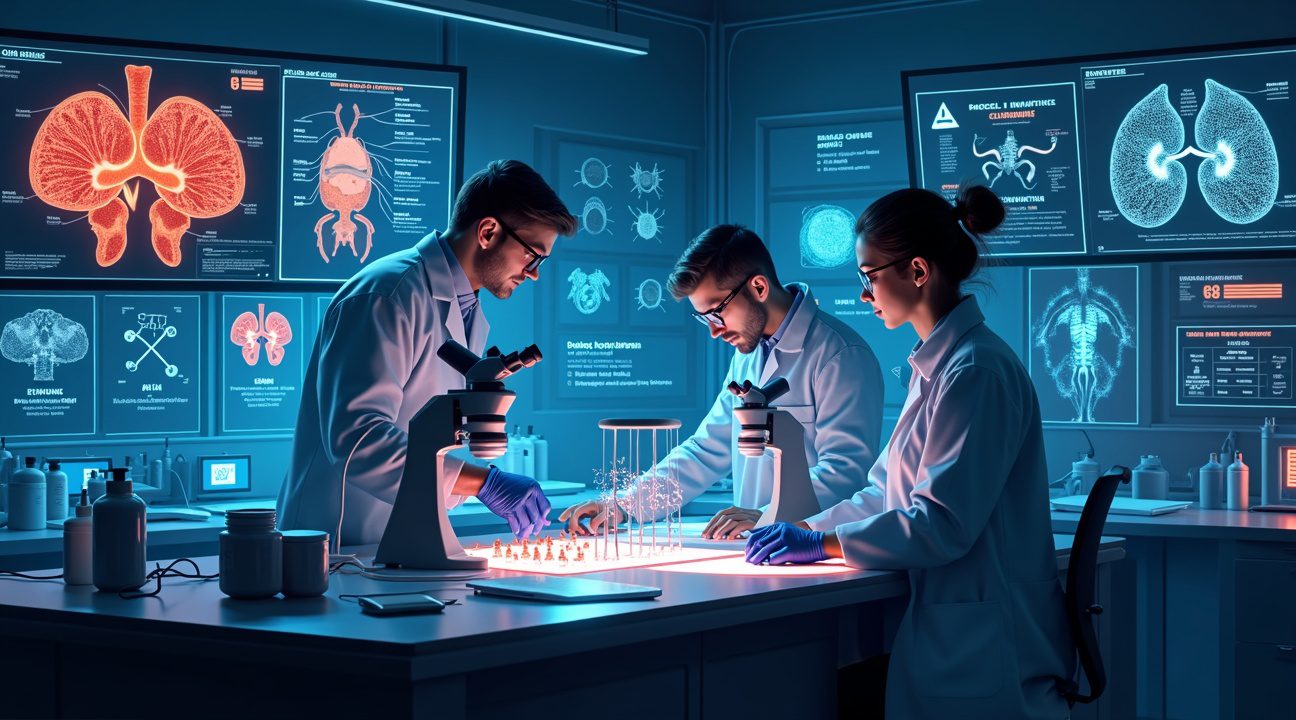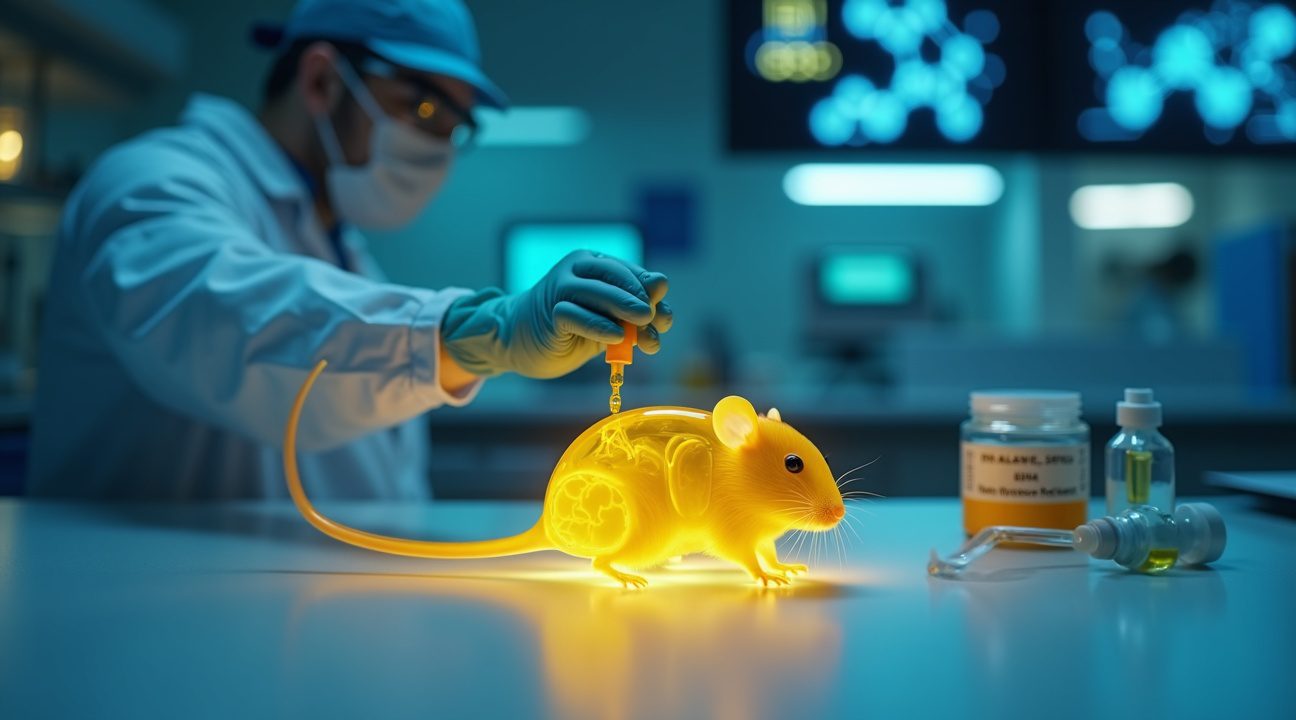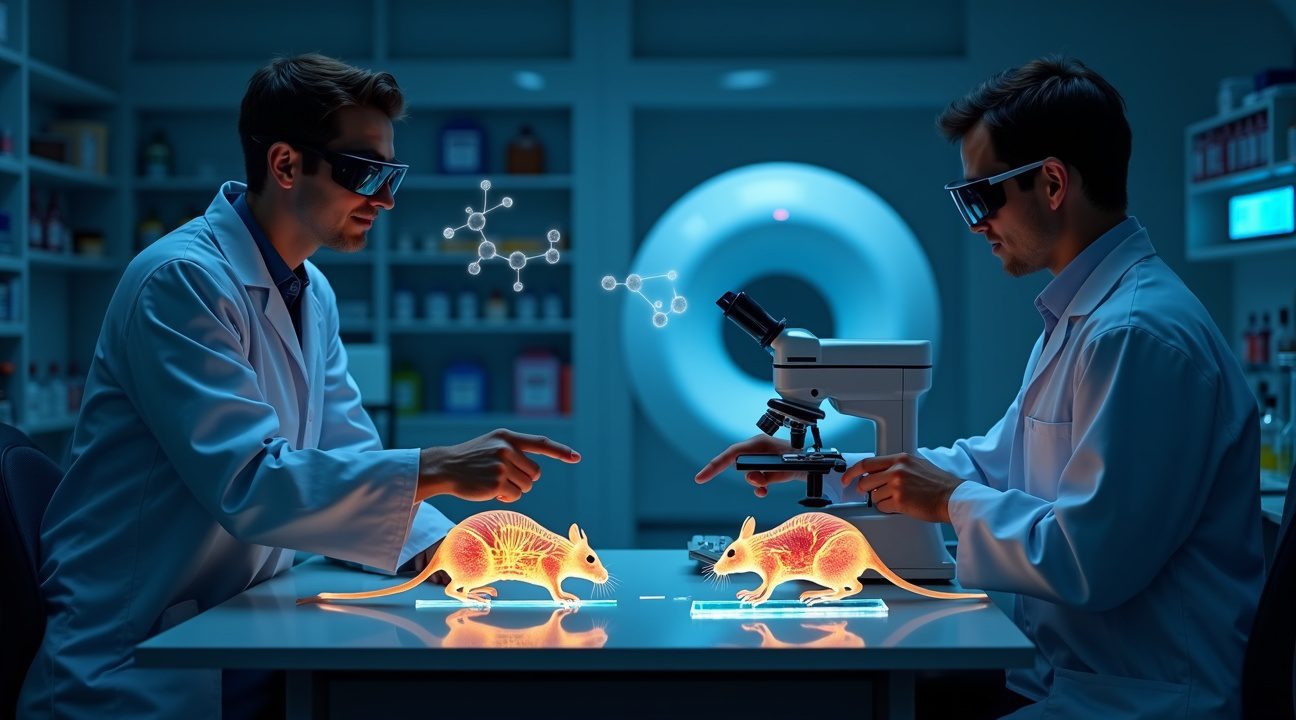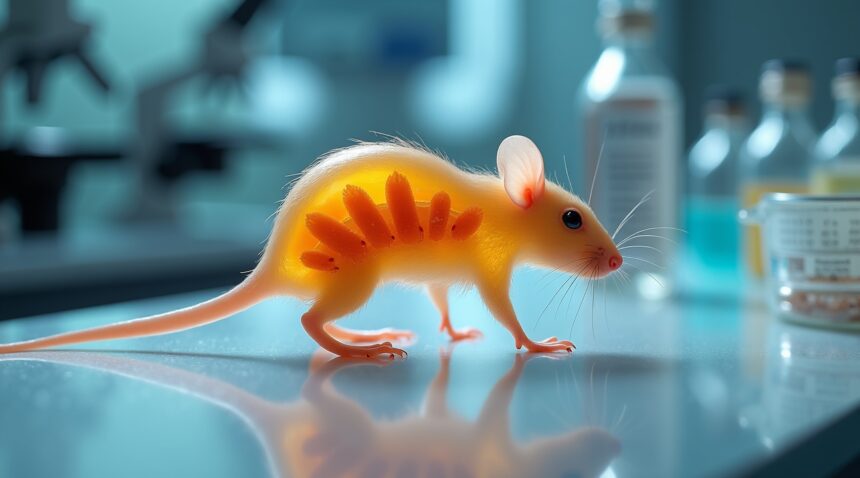Scientists achieved a breakthrough that resembles science fiction: tartrazine, the yellow food dye present in Doritos and other snacks, makes living mouse skin transparent within minutes.
This technique functions by changing how light behaves when it encounters tissue, enabling researchers to observe internal structures like blood vessels and organ function in real-time without invasive procedures.
Key Takeaways
- Common food dye creates transparency – Tartrazine (FD&C Yellow #5), mixed with water, can make living mouse tissue see-through by changing light scattering properties.
- Effect is completely reversible – The transparency can be easily reversed by washing the treated area with water, making it safe for repeated use.
- Real-time observation of internal processes – Researchers can directly watch blood flow, brain activity, and digestive system movements without surgery or expensive imaging equipment.
- Potential medical applications – The technique could revolutionize non-invasive diagnostics, surgical procedures, drug testing, and medical education.
- Human application faces challenges – While promising, human skin is 10 times thicker than mouse skin, requiring significant research to overcome penetration and safety barriers before clinical use.
The discovery leverages basic physics principles that govern light interaction with biological tissues. Tartrazine molecules alter the refractive index of skin cells, reducing light scattering that normally makes tissue opaque. This creates a window effect, allowing light to pass through tissue layers that would typically block visibility.
Researchers apply the dye solution topically to achieve transparency effects. The process requires no special equipment beyond standard laboratory materials. Results appear within two to three minutes of application, demonstrating the technique’s rapid effectiveness.
Medical imaging stands to benefit enormously from this advancement. Current methods like MRI and CT scans require expensive equipment and often involve radiation exposure. This dye-based approach offers a safer, more accessible alternative for many diagnostic applications.
The reversible nature of the transparency effect addresses safety concerns that might arise with permanent tissue modification. Simple water washing restores normal skin opacity, suggesting minimal long-term effects on treated tissues.
Human applications present significant scaling challenges. Human skin thickness exceeds mouse skin by roughly ten times, creating penetration barriers that current formulations cannot overcome. Research teams must develop enhanced delivery methods or modified dye concentrations to achieve similar transparency effects in human subjects.
Safety testing for human use requires extensive clinical trials. While tartrazine enjoys FDA approval as a food additive, topical medical applications demand different safety evaluations. Researchers must establish proper dosage limits, potential allergic reactions, and long-term effects before clinical implementation.
Potential Applications
Surgical Procedures
The technique opens new possibilities for surgical procedures. Surgeons could potentially see through skin layers to locate blood vessels, nerves, and other critical structures without making incisions. This capability could reduce surgical complications and improve precision during delicate operations.
Drug Testing and Development
Drug development processes could incorporate this transparency method to observe how medications affect internal organs in real-time. Pharmaceutical companies might reduce testing timeframes and improve understanding of drug mechanisms through direct visual observation.
Medical and Biological Education
Educational applications extend beyond medical training. Students could observe living biological processes directly rather than relying on static images or computer simulations. This hands-on approach could enhance understanding of anatomy and physiology concepts.
Ongoing Research and Future Goals
Research teams continue investigating optimal dye concentrations and application methods. Different tissue types may require adjusted formulations to achieve desired transparency levels. Scientists also explore combining tartrazine with other compounds to enhance penetration or extend duration effects.
The breakthrough represents a significant step forward in optical tissue manipulation. Simple, accessible materials create sophisticated scientific capabilities previously requiring complex equipment. This democratization of advanced imaging techniques could accelerate research progress across multiple scientific disciplines.
Future developments may expand beyond visual transparency to include other optical properties. Researchers might develop techniques for enhancing contrast, filtering specific wavelengths, or creating temporary optical markers for tracking biological processes.
The discovery demonstrates how everyday materials can solve complex scientific challenges. Tartrazine’s dual role as food additive and research tool highlights the importance of exploring unconventional applications for common substances.
Food Dye Turns Living Mouse Skin Transparent in Minutes
Scientists have achieved something that sounds like science fiction: making living mouse skin transparent using nothing more than water and a common snack dye. This breakthrough involves tartrazine, also known as FD&C Yellow #5, the same food coloring that gives Doritos their distinctive orange hue and brightens countless candies and sodas.
The Simple Science Behind Transparency
The process works by fundamentally changing how light behaves when it encounters skin tissue. Researchers applied a solution mixing water with tartrazine directly onto the mouse’s skin, and within minutes, the treated areas became see-through with a distinctive orangish tint. This transformation happens because the dye alters light scattering properties in the tissue, allowing observers to see through what was previously opaque skin.
What makes this discovery particularly remarkable is its simplicity. The same food coloring found in everyday snacks can temporarily transform living tissue transparency. Unlike complex medical procedures or expensive laboratory compounds, this technique relies on a biocompatible dye that’s already approved for human consumption. The transparency effect appears quickly—often within just a few minutes of application—making it practical for various research applications.
Reversible Results and Practical Applications
The transparency effect proves completely reversible, which addresses major safety concerns about permanent tissue alteration. Scientists can restore normal skin opacity simply by rinsing the treated area with water. This reversibility makes the technique particularly valuable for research applications where temporary visualization is needed without causing lasting changes to the subject.
The discovery opens doors for numerous medical and research applications. Scientists studying blood flow, organ function, or tissue development could use this method to observe internal processes without invasive procedures. The technique might eventually help doctors examine patients more effectively, though extensive testing would be required before human applications. Research into advanced scientific discoveries continues to push boundaries in unexpected ways.
This breakthrough demonstrates how everyday materials can lead to extraordinary scientific advances. The fact that a common snack dye can achieve temporary transparency in living tissue challenges conventional thinking about biological opacity. Researchers didn’t need exotic compounds or expensive equipment—just water and FD&C Yellow #5 created this dramatic visual effect.
The orangish tint that accompanies the transparency provides additional visual information while maintaining the see-through quality. This coloration doesn’t interfere with the ability to observe underlying structures; instead, it often enhances contrast and makes internal features more visible to researchers.
Safety considerations remain paramount, especially since the technique involves applying substances directly to living tissue. However, tartrazine’s existing approval as a food additive suggests good biocompatibility. The water-based solution further reduces potential risks compared to alcohol or chemical-based alternatives that might irritate sensitive tissues.
Future research will likely explore different concentrations, application methods, and potential uses across various species. Scientists might investigate whether other food dyes produce similar effects or if combining multiple dyes creates enhanced transparency. The technique’s simplicity makes it accessible to researchers worldwide, potentially accelerating discoveries in fields ranging from developmental biology to medical diagnostics.
This discovery joins other recent scientific breakthroughs that seem almost magical in their simplicity. Just as researchers have made advances in areas like liquid robotics and transportation technology, this transparency technique shows how innovative thinking can transform ordinary materials into powerful research tools.
The implications extend beyond immediate laboratory applications. Understanding how tartrazine affects light scattering in biological tissues could lead to new imaging techniques, improved surgical procedures, or enhanced diagnostic methods. This discovery proves that sometimes the most groundbreaking scientific advances come from the most unexpected sources—in this case, the snack aisle.

How Scientists Made Mice See-Through Using Simple Ingredients
The breakthrough that enabled scientists to make living mice transparent begins with an unexpected ingredient found in everyday snacks. Researchers discovered that tartrazine, the same yellow food dye that gives Doritos their distinctive color, possesses remarkable optical properties that can render biological tissues see-through.
The experimental process starts with researchers carefully shaving the test mice to remove fur that would otherwise block the dye’s penetration. Scientists then apply a carefully prepared water-tartrazine mixture directly to specific body regions, including the scalp, abdomen, and legs. This application method ensures the dye can effectively diffuse through the skin and into underlying tissues.
The Science Behind Tissue Transparency
The mechanism that creates transparency relies on tartrazine’s unique ability to absorb specific wavelengths of light while simultaneously altering the refractive index of water within biological tissues. Under normal circumstances, tissues appear opaque because proteins, lipids, and water all have different refractive indices, causing light to scatter in multiple directions as it passes through.
Tartrazine changes this fundamental property by matching the refractive index of water to that of proteins and lipids within the tissue. This alignment dramatically reduces light scattering, allowing light to pass through tissues with minimal interference. The result creates an almost glass-like transparency that reveals internal structures previously hidden from view.
This transparency effect enables researchers to observe remarkable details that typically require specialized equipment. Scientists can directly visualize:
- Blood vessels flowing across the brain’s surface
- Intestinal peristalsis – the wave-like muscle contractions that move food through the digestive system
These observations can be done using nothing more than a bright light and the tartrazine solution.
The biocompatibility of tartrazine makes this technique particularly valuable for live tissue studies. Unlike other transparency methods that require tissue fixation or specialized imaging equipment, this approach works on living subjects without apparent harm. Research innovations like this demonstrate how common materials can lead to extraordinary scientific discoveries.
Perhaps most remarkably, the transparency effect proves completely reversible. Researchers can restore normal tissue opacity simply by washing off any remaining dye with water. This reversibility opens possibilities for repeated observations of the same subjects over time, something that’s particularly valuable for studying biological processes that change or develop gradually.
The simplicity of this technique could revolutionize how scientists study living systems, potentially making advanced biological research more accessible to laboratories without expensive imaging equipment.
Revolutionary Potential for Medical Research and Procedures
This groundbreaking discovery opens unprecedented opportunities for noninvasive imaging that could fundamentally change how medical professionals approach diagnosis and treatment. The ability to make living tissues transparent using common food dye represents a paradigm shift in biomedical research, offering scientists and doctors direct visualization capabilities that were previously impossible without surgical intervention.
Real-Time Tissue Observation Without Surgery
Medical researchers can now observe critical biological processes as they happen, eliminating the need for invasive procedures that often carry significant risks. The technique enables direct observation of:
- A beating heart in action, allowing cardiologists to study cardiac function in real-time
- Digestive system movements and processes, providing gastroenterologists with unprecedented insights
- Blood flow patterns through various organs and tissues
- Cellular interactions and responses to medications or treatments
- Organ development and regeneration processes
The implications for medical procedures extend far beyond simple observation. Surgeons could potentially use this transparency technique to guide complex operations with enhanced precision, reducing complications and improving patient outcomes. Unlike traditional imaging methods that provide static snapshots, this approach offers continuous, real-time monitoring of biological processes.
Early cancer screenings could become dramatically more effective through this technology. Doctors might detect cellular changes and tumor formation much earlier than current methods allow, potentially saving countless lives through improved early intervention. The transparency effect could reveal microscopic abnormalities that would otherwise remain hidden until they progress to more advanced stages.
Tattoo removal procedures represent another promising application area. The ability to see through skin layers could help practitioners target ink deposits more precisely while minimizing damage to surrounding healthy tissue. This enhanced visibility during laser treatments could reduce the number of sessions required and improve overall results.
Research into life-building processes could benefit enormously from this transparency technique. Scientists studying cellular development, organ formation, and tissue regeneration would gain invaluable insights by observing these processes in living subjects rather than relying on post-mortem examinations or static imaging.
The pharmaceutical industry stands to gain significantly from this advancement. Drug testing and development could accelerate as researchers observe how medications interact with specific organs and tissues in real-time. This direct visualization would provide more accurate data about drug efficacy and potential side effects, potentially reducing the time and cost associated with bringing new treatments to market.
Medical education could also experience transformation through this technology. Students could observe living anatomy and physiology directly, gaining deeper understanding of how the human body functions. This hands-on learning approach might produce more skilled healthcare professionals who better understand the intricate workings of biological systems.
Emergency medicine applications show particular promise. First responders and emergency room physicians could quickly assess internal injuries without waiting for imaging equipment or results. This immediate visualization capability could prove crucial in trauma situations where every second counts.
Veterinary medicine presents another frontier for this technology. Animal healthcare professionals could examine pets and livestock with the same non-invasive transparency techniques, improving diagnosis and treatment outcomes while reducing stress on animal patients.
The technique’s safety profile appears encouraging since it utilizes food-grade dye already approved for human consumption. This existing safety data could accelerate the path to clinical trials and eventual medical applications, though extensive testing will still be necessary to ensure safety for transparency applications.
Research institutions worldwide are likely investigating adaptations of this discovery for human use. The potential to revolutionize medical imaging, surgical procedures, and diagnostic capabilities represents one of the most significant advances in biomedical research in recent years. As scientists continue refining the technique and exploring its applications, the medical field anticipates transformative changes in how they approach patient care and technological advancement in healthcare delivery.

What Works and What Doesn’t: The Method’s Limitations
The tartrazine transparency technique demonstrates remarkable potential, yet researchers acknowledge several critical constraints that limit its immediate applications. I’ve observed that while the initial findings appear promising, the method faces substantial hurdles before broader implementation becomes feasible.
Biological and Technical Constraints
Human skin presents the most significant barrier to this technique’s translation from laboratory to clinical settings. The structural differences between mouse and human tissue create fundamental challenges that researchers must address. Human skin measures approximately 10 times thicker than mouse skin, which dramatically reduces the penetration depth of the food dye solution. This thickness variation means that achieving similar transparency effects in humans would require either higher concentrations or entirely different delivery mechanisms.
Blood-rich tissues and areas with high protein content remain stubbornly opaque despite tartrazine treatment. The refractive index mismatch between these dense tissues and the surrounding dye solution prevents complete optical clearing. Organs with extensive vascular networks, such as the liver and kidneys, show limited transparency improvement compared to less vascularized structures.
Fluorescent imaging compatibility presents another technical hurdle. The orange tint produced by tartrazine interferes with standard fluorescent dyes commonly used in medical imaging and research applications. This interference limits the technique’s utility in studies requiring multiple imaging modalities or specific fluorescent markers. Researchers must either develop new compatible imaging protocols or find alternative transparency agents that don’t conflict with existing fluorescent systems.
Safety and Future Development
Safety considerations remain paramount despite tartrazine’s established track record in food applications. While the FDA approves tartrazine for consumption, topical application in concentrated doses hasn’t undergone rigorous human testing. The absorption rates, potential skin irritation, and long-term effects of repeated exposure require extensive investigation before human trials can begin. Unsupervised experimentation poses unknown risks and researchers strongly discourage such attempts.
Current research trajectories focus on identifying additional molecules that could enhance or replace tartrazine’s transparency effects. Scientists are exploring compounds that might achieve greater tissue penetration while maintaining safety profiles suitable for human use. These investigations parallel efforts to develop more effective delivery systems that could overcome the skin thickness barrier without requiring potentially harmful concentrations.
The development of targeted delivery methods represents a crucial research priority. Scientists are investigating techniques that could facilitate deeper dye penetration, including:
- Microneedle applications
- Ultrasonic enhancement
- Specialized carrier molecules
These approaches might enable effective transparency in thicker tissues while maintaining acceptable safety margins.
I find it fascinating how this research connects to broader scientific discoveries, much like how NASA scientists find essential building blocks in unexpected places. The transparency technique also shares innovative qualities with other breakthrough technologies, including recent developments where a robot escapes by turning liquid.
Dosage optimization remains an active area of investigation. Researchers are working to establish minimum effective concentrations that achieve desired transparency while minimizing potential side effects. This balance becomes particularly critical when considering human applications, where safety margins must be substantially larger than those acceptable in laboratory animal studies.
The technique’s current limitations don’t diminish its potential impact on medical imaging and surgical procedures. Instead, these constraints define the research roadmap for the coming years. Scientists anticipate that addressing skin thickness challenges and developing compatible imaging systems will unlock applications in non-invasive diagnostics, surgical guidance, and research methodologies.
Future iterations of this technology might incorporate multiple transparency agents working synergistically to overcome current limitations. Researchers are also exploring whether the technique could be combined with existing medical imaging technologies to enhance visualization capabilities without requiring complete tissue transparency.

Safety Profile and Practical Considerations
FDA-Approved Components and Natural Processing
The research team utilized remarkably simple and accessible materials for their transparency breakthrough. Tartrazine, commonly known as FD&C Yellow #5, serves as the active compound when mixed with water. This particular dye has maintained FDA approval for food use for decades, appearing in countless products from beverages to candies.
What makes this discovery particularly fascinating is how naturally the mouse bodies process the solution. The tartrazine doesn’t accumulate in tissues or create lasting changes. Instead, the mice metabolize and excrete the compound through their normal biological processes. Laboratory observations spanning several weeks showed no adverse effects in test subjects, indicating the temporary nature of the transparency effect.
Application Methods and Economic Viability
The practical application couldn’t be simpler. Researchers apply the tartrazine solution directly to the skin, much like spreading a facial cream. The consistency and application method make it accessible even to those without specialized laboratory training. The speed of the effect is particularly remarkable—transparency begins appearing within minutes of application.
Cost-effectiveness stands out as another major advantage. Both tartrazine and water represent some of the most affordable materials available for scientific research. This economic accessibility could accelerate research timelines and make the technique available to laboratories with limited budgets. The small quantities required for effective results further enhance the cost benefits.
However, scientists strongly caution against unregulated at-home experimentation. While the materials seem harmless individually, proper safety protocols remain essential. The controlled laboratory environment allows researchers to monitor subjects continuously and respond to any unexpected reactions. Without these safeguards, even FDA-approved substances could pose risks when used improperly.
The application simplicity that makes this technique attractive also creates potential for misuse. Researchers emphasize that medical supervision and proper training are crucial before attempting any transparency experiments. The ease of application shouldn’t overshadow the importance of understanding dosage, application areas, and potential interactions with other substances.
Professional laboratories maintain strict protocols for handling any chemical compound, regardless of its FDA status. These procedures include:
- Proper ventilation
- Protective equipment
- Emergency response plans
I believe these precautions become even more critical when working with compounds that dramatically alter tissue appearance, as visual changes could mask other physiological effects.
The scientific community continues monitoring long-term effects despite initial safety observations. While weeks of post-exposure observation showed no problems, extended studies will provide more comprehensive safety data. This ongoing research approach reflects responsible scientific practice, particularly when dealing with techniques that could eventually transition from laboratory settings to medical applications.
The combination of accessibility and effectiveness makes this discovery particularly intriguing for future research applications. However, the research team’s emphasis on controlled environments and proper protocols serves as an important reminder that scientific breakthroughs require careful implementation, regardless of how simple the underlying materials might appear.
Future applications may expand beyond laboratory mice, but each step will require careful safety evaluation. The current success with mice provides an excellent foundation, but researchers understand that what works safely in one species may require significant modifications for others. This cautious approach ensures that the promising transparency technique develops responsibly while maintaining its potential for groundbreaking scientific discoveries.

How This Compares to Existing Medical Imaging
I find the tartrazine transparency technique fascinating when measured against conventional medical imaging methods. This innovative approach offers a fundamentally different way to visualize living tissue by modifying how light passes through biological structures. The tartrazine solution works by changing the refractive index of tissues and reducing light scatter, creating a window-like effect that allows direct visualization of internal organs and structures in real-time.
Revolutionary Direct Visualization vs. Traditional Methods
Traditional imaging technologies rely on complex interpretation of reflected signals or radiation patterns. X-rays capture shadows created by dense tissues, ultrasound translates sound wave echoes into images, and MRI uses magnetic fields to detect hydrogen atoms in water molecules. These methods require specialized equipment that costs hundreds of thousands of dollars and trained technicians to operate effectively.
The tartrazine method stands apart because it provides direct visual access to internal structures. Scientists can literally see through treated tissue with standard optical equipment, observing blood flow, organ function, and cellular activity as it happens. This noninvasive imaging approach eliminates the need for complex signal interpretation that characterizes conventional methods.
Cost and Accessibility Advantages
I’m struck by the dramatic cost difference between tartrazine transparency and established imaging technologies. The tartrazine solution uses food-grade dye that costs mere dollars per application, while a single MRI scan can cost thousands. Hospital imaging departments invest millions in equipment maintenance, specialized facilities, and radiation shielding requirements.
Researchers have demonstrated that this refractive index manipulation technique requires only basic optical equipment that most laboratories already possess. The accessibility of materials means smaller research facilities and developing regions could potentially access advanced imaging capabilities without massive infrastructure investments.
However, several limitations prevent immediate clinical application:
- The transparency effect remains temporary, lasting only during active treatment with the tartrazine solution.
- Current research has been confined to mice, leaving questions about scalability to larger organisms and eventual human application unanswered.
- Safety profiles for extended or repeated use haven’t been established through long-term studies.
Traditional imaging methods maintain significant advantages in clinical settings. These proven technologies can penetrate deeply into human tissue, providing detailed images of structures several inches below the surface.
- X-rays reveal bone fractures and dense abnormalities.
- MRI offers unparalleled soft tissue contrast without radiation exposure.
- Ultrasound provides real-time imaging of moving structures like the heart and developing fetuses.
The established imaging modalities also benefit from decades of clinical validation and regulatory approval. Doctors understand their limitations, artifacts, and diagnostic capabilities thoroughly. Treatment protocols have been refined through millions of patient examinations, creating standardized approaches that ensure consistent, reliable results.
I observe that radiation risks associated with X-rays and CT scans represent a legitimate concern, particularly for pediatric patients and pregnant women. However, these risks are well-quantified and managed through careful exposure protocols. The tartrazine method’s long-term biological effects remain unknown, requiring extensive safety testing before clinical consideration.
The experimental nature of tissue transparency research means it currently serves research purposes rather than diagnostic applications. Scientists are exploring its potential for studying disease progression, drug delivery mechanisms, and cellular behavior in living organisms. These research applications could eventually lead to breakthrough discoveries that benefit multiple fields of medicine.
Looking ahead, I anticipate that direct visualization through refractive index manipulation might complement rather than replace existing imaging technologies. Each method offers unique strengths that address different diagnostic needs. The cost comparison heavily favors tartrazine transparency for research applications, while established methods remain essential for comprehensive clinical care.
The transparency technique’s ability to provide real-time observation of biological processes could revolutionize how researchers study life-building mechanisms and cellular interactions. This direct visualization capability opens possibilities for understanding complex biological systems in ways that traditional imaging simply can’t match.

Sources:
University of Texas at Dallas News, “Researchers Create Solution That Makes Living Skin Transparent with Food Dye”
C&EN, “Food dye makes tissue temporarily transparent”
Science News Explores, “Orange food dye can temporarily turn skin transparent”
Science.org, “Slathering mice in a common food dye turns their skin transparent”
KCRW, “Scientists are making mice transparent using a common food dye found in Doritos”
Live Science, “Scientists just made mice ‘see-through’ using food dye”
Stanford News, “Researchers make mouse skin transparent using a common food dye”


